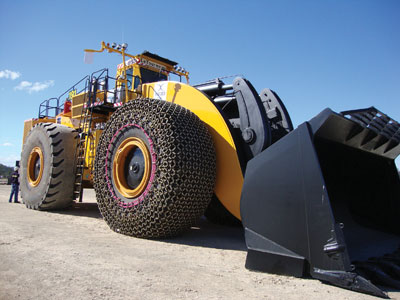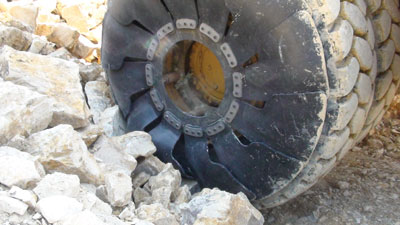
Armoured up
By RUD-Erla
Features Tech tipsIn mining, quarrying and some earthmoving applications, dump trucks used to carry waste, ore or coal from the working face to the processing plant rely on large, expensive, earthmover tires to carry out their tasks.
In mining, quarrying and some earthmoving applications, dump trucks used to carry waste, ore or coal from the working face to the processing plant rely on large, expensive, earthmover tires to carry out their tasks.
 |
|
| One damaged tire at a mining operation means an entire team out of production. Using tire protection chains enables mine operators to use wheeled vehicles without excessive downtime.
|
Depending on site conditions, these tires can be subject to poor traction, abrasive attrition and sidewall damage. Poor traction due to soft clay conditions or iced-up haul roads is a safety issue. A skidding, 400-tonne truck is a dangerous thing. Tire abrasion is an asset issue. Abrasion can rapidly destroy tires, leading to premature and costly replacement.
Truck operators have overcome both these problems by adopting the same remedies used to protect the tires of wheeled loading shovels, bulldozers and graders. Fitting a suitably patterned, durable set of tire protection or traction chains to the truck’s drive wheels provides extra grip and absorbs abrasion, in effect doubling or tripling tire life.
For trucks, there remains the risk of sidewall damage from sharp flints and shale-like debris and, once damaged in this way, the weakened tire becomes a write-off with no possibility of extended life as a re-mould. Although haul roads are regularly cleared of spills and rock falls, it only takes one stray flint to instantly destroy a tire and disable a truck with the consequent interruption to productivity.
With loader, bulldozer and grader tires it is accepted practice to protect tires from sidewall damage with an impenetrable, tight-meshed chain but, while tire protection chains have been tried with dump trucks, the long travelling distances involved make this solution impracticable and short-lived.
Some 70 years ago, responding to the needs of the newly arrived pneumatic-tired mining loaders, RUD-Erlau devised and developed the first tire protection chains, going on to hold over 65 per cent of the world market for tire protection and traction chains in mineral mining, forestry, scrap, demolition, steel making and other heavy industries. Due to feedback from their tire-protection-chain engineers, RUD-Erlau was well aware of the vulnerability of dump truck tires and asked the research and development team to tackle the problem.
With more than 130 years’ experience in the development and manufacture of chain components, the team’s first instinct was to create a device based on steel-alloy elements. However, success only came when the team turned its attention to materials used in other industries and developed Sideflex. A sturdy set of replacement wheel nuts and extensions supports a simple steel ring to which is attached a fanned array of overlapping platelets. These platelets shield the entire sidewall of the truck tire, deflecting rock fragments harmlessly away.
 |
|
| New tire protection devices use advanced automotive polymers to armour-plate the sidewall, protecting it from sharp rocks and other debris.
|
While the mounting components are made of steel, the all-important Sideflex shield is manufactured from a sophisticated engineering polymer that has found many applications in automotive and other industries. This robust material, which is used to protect automobiles, has a unique memory capability that enables the platelets to flex and deform upon impact and then return to their original shape without any loss of integrity.
The entire Sideflex assembly is so lightweight and low-profile that owners of dump trucks – small and large – have, for the first time, a cost-effective means of protecting and saving their expensive tires. Having already undergone many months of extensive real-life, no-holds-barred field trials in quarries, Sideflex is performing well and delivering its promised potential.
An example of how tire protection chains can protect assets and boost productivity can be found at the Mangoola coal mine. Xstrata celebrated the inception of its latest coal mine in 2010. Having, purchased the Anvil NSW mine project from Centennial Coal Company for $425 million back in September 2007, Xstrata had invested close to $1 billion to bring the now-named Mangoola mine to production in 2011. Located about 20 kilometres west of Muswellbrook and about 10 kilometres north of Denman in the Upper Hunter Valley of New South Wales in Australia, the open-cut Mangoola mine is set to deliver coal for domestic use and export grossing, at current world prices, some $900 million per year over an expected 18-year mine life.
Now a fully operational mine with the coal handling and preparation plant working and all outstanding equipment on site, trains are already transporting coal either to Macquarie Generation’s Bayswater and Liddell power stations or to the port of Newcastle for shipment to customers in eastern Asia. Three hundred employees have been engaged for Mangoola Coal’s day-to-day operations and a further 700 indirect employment opportunities are expected to arise from the development.
With first-class equipment and a skilled workforce, the Mangoola Project was delivered three months ahead of schedule and $178 million under budget. Site preparation and infrastructure improvements kicked off in January 2009 and by February 2010, the earthworks, coal handling, preparation plant and rail facility were in place. August 2010 saw commencement of overburden stripping and by November that year the first run-of-mine coal was being stockpiled. Just three months later, in February 2011, the first coal wash took place and was entrained just 11 days later.
The yellow iron inventory at the mine is impressive, with Liebherr, Cat and LeTourneau featuring high on the shopping list. Four teams of earthmovers, supported by SKF drill rigs and Cat 773 service carts, are bringing home the coal. One team is headed by a new Liebherr model, the 1,250-kilowatt R9400 backhoe excavator equipped with a high-capacity 22-cubic-metre, 40-tonne bucket. Five, 137-cubic-yard, 195-ton Cat 789 dump trucks, a Push Cat and a tracked Cat D11 bulldozer complete the waste stripping and coal excavation set.
A second team, also engaged in waste removal and coal extraction, consists of a 1,287-horsepower, turbocharged, tracked Liebherr R9250 with a 17-cubic-metre bucket and 11-metre dump height; six CAT 789 dump trucks with a combined carrying capacity of 2,400 tons; two 433-kilowatt CAT D10 tractor-dozers and a 854K model Push Cat.
Designated for waste disposal duties, with an operating weight of over 660 tonnes, is the flagship: a 2,240-kilowatt Liebherr R966 crawler faceshovel sporting a 34-cubic-metre, 60-tonne bucket supported by two 170-cubic-metre, 240-ton, CAT 793 dump trucks, two 634-kilowatt CAT D11 track-mounted bulldozers, a 7.3-metre-wide CAT 24M grader and a 100-ton, CAT 777 watercart.
Delivered in September 2009, the core unit at the mine includes a LeTourneau L1850 loader, six CAT 793s with a combined haul capacity of 1,440 tons, a 16M Grader with a 4.9-metre mold board, a CAT D10 bulldozer and a further 100-ton CAT 777 watercart. Considered one of the most popular in LeTourneau’s loader line, the L-1850 is offered with a 30-cubic-metre, 54-tonne bucket as standard equipment. Powered by a 1,419-kilowatt diesel engine, the L-1850 is designed to centre-load most haul trucks rated for payloads between 236 and 327 tonnes.
Mother Nature had no thought for the miner when she laid down the Mangoola deposits. Concealed by 15-90 metres of sandstone conglomerate, the three 9-10 metre coal seams are inter-bedded with three- to four-metre-thick, late-Permian, tuffaceous bands. Tuff is an unforgiving mixture of volcanic rock and mineral fragments in a volcanic ash matrix, formed when a combination of ash, rock and pyroclastic or tephra mineral fragments were blasted into the air by volcanic action then fell to the ground as a mixed deposit.
The L1850 loader’s Michelin X-Mine D2 60/80-57 tires are subject not only to heavy abrasion from the sandstone and tuff but are also under constant threat of sidewall damage from such unpredictable content as razor-sharp, unweathered shards of rock. As the only wheeled loader on site, the Letourneau is far too valuable an asset to be standing idle for want of a tire when it should be earning its keep loading trucks. Given the current limited availability of giant earthmover tires and high replacement costs, Mangoola has taken practical, pre-emptive steps to save unnecessary expense and unwelcome delays in production. From its arrival, new, in August 2010, Mangoola has protected the L-1850’s drive-wheel Michelins with a pair of Fels Crown X22 tire-protection chains. Supplied, installed and supported by RUD Australia and manufactured by RUD Kettenfrabrik of Germany, the chains provide the all-round protection that keeps loaders such as the L-1850 operating on schedule.
The robust, tight-meshed, 22-metre, ribbed links of RUD’s Fels Crown encase the tire, absorbing abrasion that would otherwise quickly powder the tread and, by deflecting sharp rock fragments, prevent sudden-death, sidewall penetration. While the extension of a new tire’s life up to three times is a significant benefit, another big plus is seen in guaranteeing productivity through assured plant availability and a significantly reduced cost per delivered tonne.
Since fitting the tire protection chains, the L-1850 has worked over 9,000 hours without reporting any unscheduled workshop visits for tire repairs or replacements.
Print this page
Leave a Reply